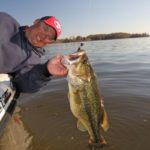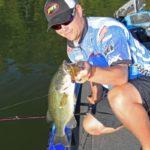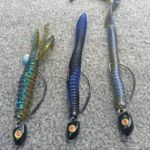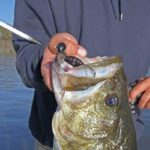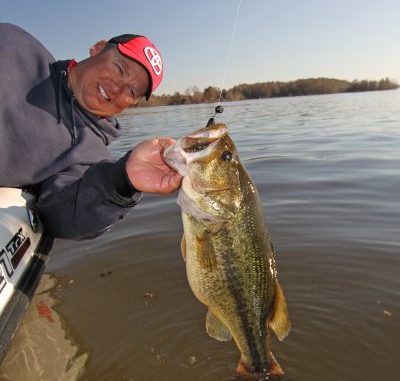
If you’re looking for a little extra action, the new swing-head jigs are perfect. And these bass-fishing experts tell you everything you need to know about how to use them effectively.
In a lake, there is no takeout menu, no vending machines, no Amazon. If you’re a bass, what you got is what you got.
Life is fine, as long as the crawfish and finfish remain in ample supply. But suffice it to say that if something different comes strolling down the lane, the “Oh boy!” factor kicks in big time.
For anglers seeking that elusive “something different,” one of the more-recent trends — the swing-head jig — offers a truly unique way of presenting a lot of the same plastics used on traditional flipping and football jigs, along with Texas and Carolina rigs.
Essentially a leadhead or tungsten head with a ring holding a free-moving hook, this design enhances the inherent motion of wiggly baits and adds action to those with more subtle designs.
Several brands offer swing heads, with the lineup including the VMC Swingin’ Rugby Jig, Strike King Jointed Structure Head, Gene Larew Hardhead, Freedom Lures Rogue, Bombshell Jiggy Hooks and Zorro Booza Whiplash.
As Toledo Bend guide Stephen Johnston pointed out, the attraction comes by way of motion unleashed.
“If you throw a regular jig or you drag a regular Texas rig, the bait is just trailing right behind the weight,” Johnston said. “When a swing head hits the bottom, the hook and whatever kind of bait you have on there is free to dance from side to side as that weight drags.
“It’s almost like a ChatterBait action on the bottom.”
Favoring the Hardhead, FLW Tour pro Andrew Upshaw said the swing-head design presents several distinct advantages over traditional football jigs.
“For one thing, you can fish the Hardhead with just about any soft-plastic offering by reeling or dragging the bait along the bottom,” he said. “Also, a regular football jig tends to hang up more because the hook is still somewhat exposed due to having a weed guard. The Hardhead just doesn’t hang up.
“The Hardhead can also be used as more of a natural, finesse presentation, and that can yield more bites than traditional jigs. Lastly, the Hardhead is more effective on hookup-to-landing ratios because of the free-swinging hook.”
As Johnston pointed out, the swing-head was designed for a steady, continuous drag, as opposed to the drag-and-pause or stroking routines common to football heads.
This means that dangling head allows him to cover more ground and locate active fish.
“You can probably get three more casts in than you can with a football head,” Johnston said.
And he said anywhere you would cast a jig or fish a Texas rig is fair game for the swing-head.
However, an open mind benefits the day’s diversity.
“A lot of people have it in their heads that you have to throw it on rock, so riprap is a good option,” he noted. “But it’s also good on a slick mud or clay bottom.
“It’s hard to cast and wind it in the grass, but you can flip it into the hyacinths and peppergrass or even roseau cane and hop it. You’re just giving the fish a different look with that bait being free and not connected like a Texas-rigged Beaver, where the weight is pegged to the bait with no freedom.”
Bassmaster Elite Series pro Dennis Tietje of Roanoke combines the wild wobbling of the Jointed Structure Head with the long, lanky profile of a 10-inch worm.
Fishing the rig fast — almost like a crankbait — he covers lots of water and gives the fish a unique look that’ll pique the interest of any fish with a rumble in its belly.
Johnston also likes a bump-and-go technique.
“You can pull it up onto a big rock or stump and pause it,” he said. “When it hits something and comes up off the bottom, it has a different look than anything those fish have ever seen.”
With football heads not too far from his swing-heads, Johnston said the latter is just another tool for the job. Sometimes, it’s the primary choice — breaking down vast water or coaxing finicky fish, for examples — while other scenarios find it serving the clean-up role.
“It’s like crankbaits — you have a square-bill, which has a wide wobble, or a shallow-running Bandit that has a narrow wobble,” he said. “The swing-head is just another weapon in your box.
“If you throw a football head on a point and you’re catching them and catching them … but then they stop, you can throw that swing-head and pick up a few more bites.”
